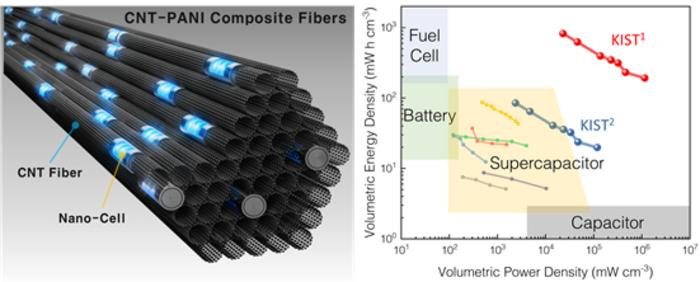Reviewed by Lexie CornerMay 12 2025
A group of researchers led by Dr. Bon-Cheol Ku and Dr. Seo Gyun Kim of the Carbon Composite Materials Research Center at the Korea Institute of Science and Technology (KIST) and Professor Yuanzhe Piao of Seoul National University (SNU) have created a high-performance supercapacitor that is anticipated to become a next-generation energy storage solution.
 (Left) Schematic illustration of a composite of CNTs and PANIs. It shows that the covalently bonded PANIs are evenly distributed among the CNTs and that each PANI can act as a nanoscale cell. (Right) The composite fiber fabricated based on these characteristics shows excellent power and energy density at simultaneously, exceeding the characteristics of general supercapacitors. (KIST1 is the value calculated by the weight of only PANI, and KIST2 is the value calculated by the weight of the fiber). Image Credit: Korea Institute of Science and Technology
(Left) Schematic illustration of a composite of CNTs and PANIs. It shows that the covalently bonded PANIs are evenly distributed among the CNTs and that each PANI can act as a nanoscale cell. (Right) The composite fiber fabricated based on these characteristics shows excellent power and energy density at simultaneously, exceeding the characteristics of general supercapacitors. (KIST1 is the value calculated by the weight of only PANI, and KIST2 is the value calculated by the weight of the fiber). Image Credit: Korea Institute of Science and Technology
Researchers have developed a new type of supercapacitor using a fiber made from single-walled carbon nanotubes (CNTs) and the conductive polymer polyaniline (PANI). This design helps solve some of the main problems with current supercapacitors.
Supercapacitors charge faster, last longer, and are more durable than regular batteries. But because they store less energy, they haven’t been widely used in things like electric cars or drones.
To fix this, the team combined CNTs with PANI at the nanoscale. This created a complex fiber structure that improves how ions and electrons move, helping the supercapacitor store more energy and release it faster.
Tests showed that the supercapacitor works well even at high voltage and stays reliable after over 100,000 charge and discharge cycles. This makes it a strong option for use in electric vehicles, where it could allow for faster charging and better performance. It could also benefit drones and robots by offering more power and longer run times.
The fiber is also flexible, so it can be folded or rolled, which makes it useful for wearable electronics and next-generation devices.
The team also found a way to lower costs. While CNTs are expensive to make on their own, combining them with affordable PANI and using a simple process made it possible to produce the material on a larger scale. They even created film-like versions of the material to help with manufacturing.
This technology could support a range of industries - from wearables to electric cars - and help move toward more sustainable energy solutions.
This technology overcomes the shortcomings of supercapacitors by using single-walled carbon nanotubes and conductive polymers. We will continue to develop and industrialize ultra-high-performance carbon fibers based on carbon nanotubes.
Dr. Bon-Cheol Ku, Korea Institute of Science and Technology
Journal Reference:
Lee, D., et al. (2025) Nanocell-Structured Carbon Nanotube Composite Fibers for Ultrahigh Energy and Power Density Supercapacitors. Composites Part B: Engineering. doi.org/10.1016/j.compositesb.2025.112179.